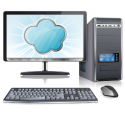Computerware Blog
Desktop Virtualization: Save Money, Increase Security
Desktop Virtualization reduces the hefty cost of computer hardware because everything is rendered, or "virtualized," from a central server. Therefore the necessity of having a large hard drive, an ample amount of RAM, and the best CPU on the market for each workstation goes away. Even the simplest of workstations can utilize programs that require a lot of resources such as modeling or CAD software.
Desktop Virtualization also simplifies software maintenance because security and maintenance patches are applied to the server instead of each workstation. Virtualized software licenses cost around the same amount, but since all your workstations are ran as virtual machines on a server, the cost per workstation is significantly lower.
You have a couple of options to choose from if you decide to support Desktop Virtualization. You can either purchase a whole fleet of bare bone machines known as terminals, designed specifically as thin client workstations for virtualized software delivery, or you can utilize your current machines and modify them for the purposes of using the virtual desktop. If you choose the second option and some of your machines are antiquated, you may need to purchase a few hardware components to get them up to par for Desktop Virtualization.
Using Desktop Virtualization also increases your company's security measures in numerous ways. You can control all of your user's accessibility, eliminating a lot of security breaches from mischief or mistakes. This will ensure outdated software exploits are eliminated because you update one central location and users render that information in a virtual environment; and in the case that a workstation stops functioning, the employees worked is stored remotely. All you have to do is move them to a new workstation to continue their work.
If Desktop Virtualization is something that you think could benefit your company, or if you want to learn more, contact Computerware at (703) 821-8200.


Comments